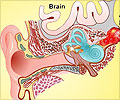While most Down syndrome research has focused on the brain, a new report uncovers how the disorder hampers a separate part of the nervous system.

‘Peripheral nervous system impairment could contribute to heart disease, diabetes and immune disorders that are associated with Down syndrome.’





The peripheral nervous system has no known role in intellectual ability, but it does regulate organ function including heartbeat, blood pressure and blood glucose. Peripheral nervous system impairment could contribute to heart disease, diabetes and immune disorders that are associated with Down syndrome. One of the most common genetic disorders, Down syndrome is caused by the appearance of a third copy of chromosome 21. It appears in one of nearly every 700 babies born in the United States; roughly 400,000 Americans are estimated to have the disorder.
Rejji Kuruvilla, an associate professor in the Johns Hopkins University Department of Biology, said, "Scientists studying the condition have mostly concentrated on the central nervous system, but that leaves out a lot. There's been a whole aspect of the nervous system that has been ignored in Down syndrome, and perhaps in other neurological disorders."
The lead author among eight collaborators is Ami Patel, who has since moved to Northwestern University after earning her doctorate in biology at Johns Hopkins.
While the connection between Down syndrome - one of the most common genetic conditions - and peripheral nervous system disease has been known for some time, the phenomenon has not been understood at the molecular and cellular level. Kuruvilla's lab pursued the question by examining both mice engineered to approximate a human Down syndrome genetic profile and human organ tissues from Down syndrome infants.
Advertisement
The research focused on nerve growth factor, or NGF, a protein identified in the 1950s - the two scientists who made the discovery later won a Nobel Prize - that regulates peripheral nervous system development.
Advertisement
The culprit emerged as a gene, RCAN1, which in Down syndrome appears in three times the number that would be found in normal chromosomes. This gene regulates a protein, calcineurin, that enables NGF to stimulate nerve growth and also support neuron survival. In a mouse model, tripling RCAN1 alone caused the loss of neurons and nerve growth; reducing the extra dose of RCAN1 improved survival of neurons and nerve development.
In other words, too much RCAN1 results in not enough calcineurin activity. Insufficient calcineurin activity leads to impeded NGF functions and, thus, impaired peripheral nervous system development.
Kuruvilla said, "The finding raises other questions that her lab plans to pursue. One is how RCAN1 affects neurons in a portion of the brain called the basal forebrain, which also responds to NGF. That brain area deteriorates in Alzheimer's disease patients."
And there is the question of possible treatments, given the array of medical conditions including cardiovascular problems and hypertension associated with peripheral nervous system dysfunction in individuals with Down syndrome.
Kuruvilla said, "When you think about therapeutic interventions that could affect life quality, it's important to not ignore this important aspect of the nervous system."
Source-Eurekalert












